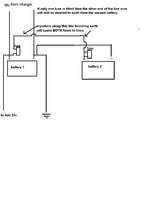Hi Guys
This might seem like a newbie question but I need an answer.
I have just bought 2 new 110amh batteries to put in the van to give me 220amh. I am replacing an old 110amh battery that came with the van.
I am a complete novice with electrics but if I were to just replace the battery like for like there would be no problem because the setup is the same, but because I am adding another leisure battery, I am confused to how they charge.
Normally on hookup I have the battery charger charging the batteries "starter and leisure" and when driving the van the alternator is charging the starter first then the leisure battery.
Now I want to add another battery to the mix, so does the battery charger that I am using now still charge both batteries, independently, together or does only 1 of the leisure batteries get charged.
Do I need a new charger to replace the one I already have do I need to put a split charger between the 2 leisure batteries?
I have looked at possible solutions but there are so many I am totally confused. Aggghhh!
Isolator switch, split relay, intelligent charger ie: ctek, sterling battery 2 battery charger?
I like the idea of having an intelligent charger like the ctek because it checks the batteries at different stages to get the best from the batteries.
Looking on google and youtube, the videos of people who have added extra batteries just hook the batteries together, in parallel of course, with not a charger or split charger in site.
Now I know that if I'm going to get a definitive answer its gonna come from one of you guys, so much appreciation in advance, and remember I know very little about electrics.
Many thanks
Gary:thumb:
This might seem like a newbie question but I need an answer.
I have just bought 2 new 110amh batteries to put in the van to give me 220amh. I am replacing an old 110amh battery that came with the van.
I am a complete novice with electrics but if I were to just replace the battery like for like there would be no problem because the setup is the same, but because I am adding another leisure battery, I am confused to how they charge.
Normally on hookup I have the battery charger charging the batteries "starter and leisure" and when driving the van the alternator is charging the starter first then the leisure battery.
Now I want to add another battery to the mix, so does the battery charger that I am using now still charge both batteries, independently, together or does only 1 of the leisure batteries get charged.
Do I need a new charger to replace the one I already have do I need to put a split charger between the 2 leisure batteries?
I have looked at possible solutions but there are so many I am totally confused. Aggghhh!
Isolator switch, split relay, intelligent charger ie: ctek, sterling battery 2 battery charger?
I like the idea of having an intelligent charger like the ctek because it checks the batteries at different stages to get the best from the batteries.
Looking on google and youtube, the videos of people who have added extra batteries just hook the batteries together, in parallel of course, with not a charger or split charger in site.
Now I know that if I'm going to get a definitive answer its gonna come from one of you guys, so much appreciation in advance, and remember I know very little about electrics.
Many thanks
Gary:thumb:

